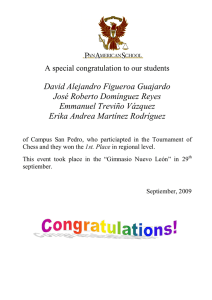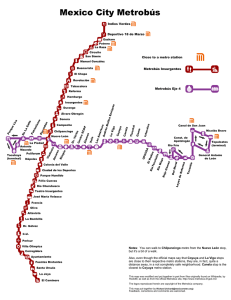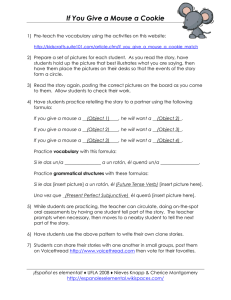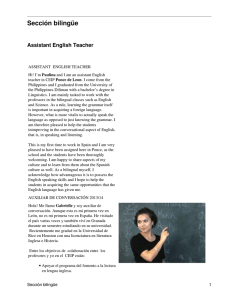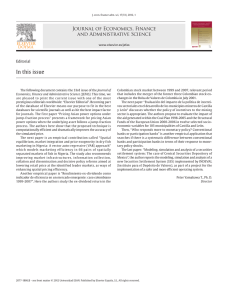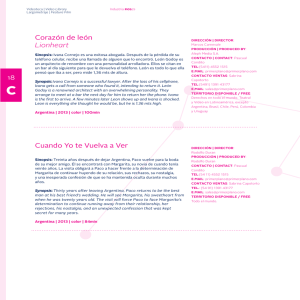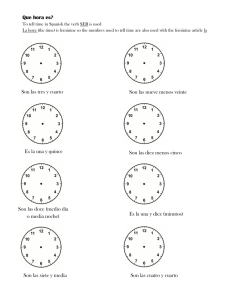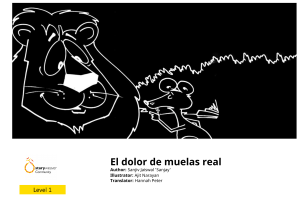El león y el ratón Un león estaba durmiendo, cuando un ratón
Anuncio
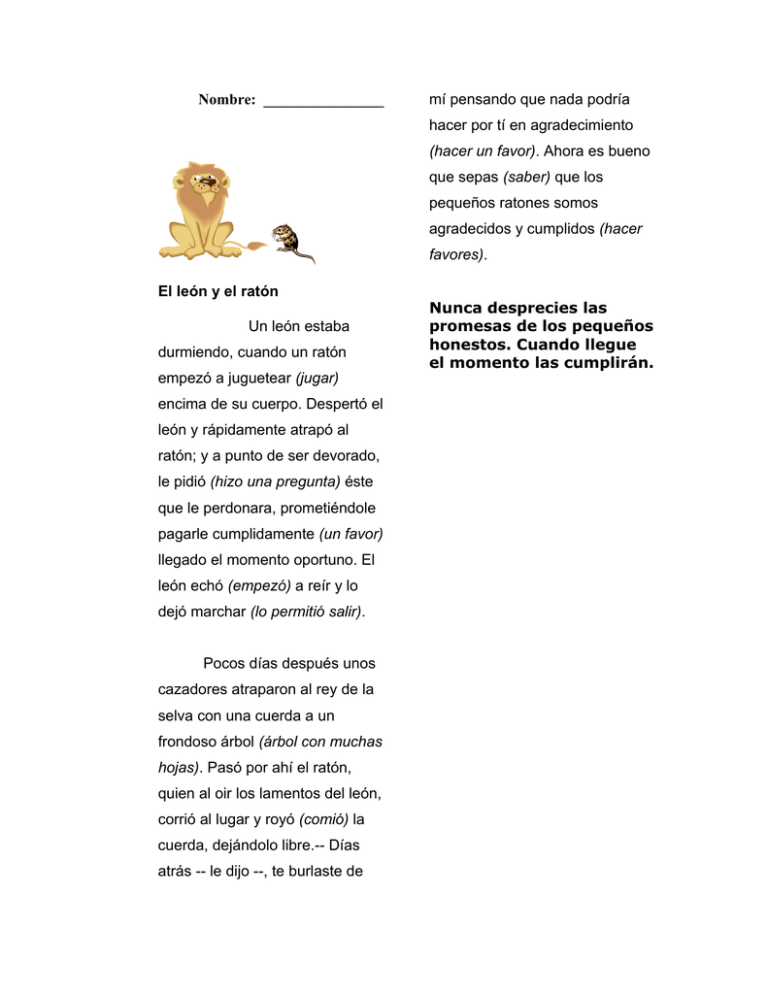
Nombre: ________________ mí pensando que nada podría hacer por tí en agradecimiento (hacer un favor). Ahora es bueno que sepas (saber) que los pequeños ratones somos agradecidos y cumplidos (hacer favores). El león y el ratón Un león estaba durmiendo, cuando un ratón empezó a juguetear (jugar) encima de su cuerpo. Despertó el león y rápidamente atrapó al ratón; y a punto de ser devorado, le pidió (hizo una pregunta) éste que le perdonara, prometiéndole pagarle cumplidamente (un favor) llegado el momento oportuno. El león echó (empezó) a reír y lo dejó marchar (lo permitió salir). Pocos días después unos cazadores atraparon al rey de la selva con una cuerda a un frondoso árbol (árbol con muchas hojas). Pasó por ahí el ratón, quien al oir los lamentos del león, corrió al lugar y royó (comió) la cuerda, dejándolo libre.-- Días atrás -- le dijo --, te burlaste de Nunca desprecies las promesas de los pequeños honestos. Cuando llegue el momento las cumplirán. Nombre: _________________ El ratón mira al 8. león en el árbol. El León y El Ratón B. Para hablar… Actividades: a. ¿Qué tipo de lectura A. El orden de las escenas… Las escenas en Columna A no están en orden. Ponlas en orden usando Columna B es? (artículo, cuento, poema, anuncio) b. ¿Dónde están el león y el ratón? (una playa, A. B. El león gana su 1. libertad, gracias al ratón. El león atrapa el 2. ratón. El ratón ayuda 3. 4. buenos amigos. El león está c. ¿Cómo es el león? d. ¿Cómo es el ratón? un león o un ratón? f. “La frase de consejo” ¿significa que los ratones pueden ser buenos amigos o realmente significa algo más? 5. durmiendo. El león está selva) e. ¿Cómo eres tú? ¿Eres al león. Los dos son una montaña, una Nombre: _______________ 6. caminado por la selva. El ratón pide por su libertad. El León y El Ratón 7. Para Escribir… A. Ideas y Opiniones En tu cuaderno de leer, escribe tus ideas y opiniones sobre el cuento “El león y el ratón.” a. Yo no entiendo… (puedes explicar en inglés o en español) b. A mí me gusta /o/ no me gusta el león porque… c. A mí no me gusta /o/ no me gusta el ratón porque… d. Mi amigo / pariente _______ es como el león porque… e. Mi amigo / pariente ________ es como el ratón porque … B. Tarea: “Para ser un buen amigo” Cuáles son las qualidades importantes para ser un buen amigo? ¿Son las características físicas más importantes que la personalidad? ¿Cómo eres tu amigo/a mejor y cómo eres tú? ¿Son uds. similares o diferentes? Usa estas preguntas para escribir un párafo sobre tu amigo/a mejor. Debe ser 8 frases (el mínimo) y incluye un dibujo o una foto de ustedes. El Rubric: 1. Sigue las instrucciones número de frases 1 menos de 6 frases 6 2. Gramática errores 1 más de 5 errores 3 3. Vocabulario repetitción de palabras 4. Foto o Dibujo qualidad Score: _______________ 1 más de 3 1 no hay leer estos cuentos? Las Fábulas de Esopo 1. ¿Qué son Fábulas de Esopo? 2. ¿Qué usa Esopo en sus cuentos? 3. ¿Por qué es importante 4. ¿Hay otros ejemplos de cuentitos que terminan con un consejo? 5. ¿Podemos usar los consejos antiguos hoy en día? Las Personalidade s de Los Animals en Las Fábulas de Esopo pequeño rápido Animales: ratón oveja carnero lobo Adjetivos: astuto tramposo engañoso arrogante tímido agresivo impaciente sencillo inteligente simpático estúpido fuerte débil grande / lento zorra poderoso conejo / liebre león Nombre: ____________________________ Fecha: ______________ Antes de leer: Las Fábulas de Esopo Aveces, los autores usan animales en sus cuentos como personajes. ¿Qué son estos animales? ¿Cómo puedes describir sus personalidades y qualidades? Es un: Personalidad y Qualidades: León / Leóna Poderoso, fuerte Post-Reading Strategies 03/10/05 Teacher: Melissa Ferro Language(s): Spanish Number of Students: 25 Grade(s): 9th Level(s): 2 Time: 90 minutes PLANNING PHASE Performance/Task- Based Objectives*: 1. Students will be able to relate personality traits to types of animals 2. Students will be able to sequence the events of the Aesop fable “The lion and the mouse” 3. Students will be able to write and share their reactions, opinions and ideas about the characters and events in the fable 4. Students will be able to write and present a short paragraph comparing their own personality traits with those of their best friend *Performance/Task-based objectives are based on ACTFL Performance Guidelines for Reading and Writing: Interpretive and Interpersonal Tasks for the Intermediate Learner. Standards: National • Standard 1.1: Students engage in conversation, provide and obtain information, express feelings and emotions and exchange opinions • Standard 1.2: Students understand and interpret written and spoken language on a variety of topics • Standard 1.3: Students present information, concepts and ideas to an audience of listeners or readers on a variety of topics • Standard 3.1: Students reinforce and further their knowledge of other disciplines through the foreign language State • SII.1: The student will exchange spoken and written information and ideas in Spanish • SII.3: The student will understand basic spoken and written Spanish on new topics in a familiar context that are presented through a variety of media. • SII.4: The student will use verbal and non-verbal cues to interpret spoken and written texts in Spanish. • SII.5: The student will present orally and in writing information in Spanish that combines learned as well as original language in simple sentences and paragraphs • SII.8: The student will use information acquired in the study of Spanish and information acquired in other subject areas to reinforce one another Local Local standards are aligned with state and national standards TEACHING PHASE (1) Preparation Lesson Outline: a. Warm-up Activity: Pre-reading questions to activate schemata b. Theme or Topic: Personality Traits / Friendships c. Vocabulary: animales: león, zorro, lobo, ratón, conejo/liebre, oveja/carnero, adjetivos: astuto, listo, tramposo, engañoso, arrogante, tímido, agresivo, impaciente, sencillo, inteligente, simpatico, estúpido, fuerte, débil, grande, pequeño, rápido, lento d. Verb(s): Ser, Hacer, Tener, Ayudar, Atrapar, Pedir e. Grammatical structure(s): Noun-Adjective Agreement, Use of Ser, Present Tense Verbs, Comparisons f. Cultural perspectives: What other cultures have stories that end with advice? Is the advice in these old stories still valuable today? g. Listening/Reading/Viewing selection(s): “El león y el ratón” (2) Presentation and (3) Practice Three Modes: Interpersonal Activities: a. “El Orden de las Escenas—Una Competición” Students will work in pairs to place the events of the story in order. b. Students will work as a group to put pictures that depict the events of the story in order Presentational Activities: a. “Ideas y Opinions” Students will share what they have written in their Reading Response Logs b. Students will present a short paragraph and a photo or drawing that depicts one of their personal friendships. Interpretive Activities: a. “Think Aloud—Para Hablar” Students will share their initial reactions and understanding of the text by answering questions orally b. Students will write a short paragraph comparing their own personality traits with those of their best friend Methods/Approaches/Strategies: a. Communicative Method / Natural Approach / Post-Reading Strategies: Literacy Scaffolding, Read Aloud, Think Aloud, Reading Response Logs, Comprehension Checks (4) Evaluation: a. Sequence of Events activities—comprehension check of text b. Think Aloud Activity—comprehension check and making connections between what they already know and what they have learned c. Reading Response Logs—comprehension check and making connections d. Writing Activity—assessed according to rubric e. Presentation of Individual Friendships—assessed according to P.A.L.S. Speaking (5) Expansion/Extension: a. Students can perform the scenes of the fable b. Students can create a modern version of the fable including illustrations c. Students can create mobiles or bumper stickers that show what it means to be a good friend d. Use additional fables for similar activities with different themes Other Activities: Materials: Handouts and overhead transparencies / chocolates / Spanish prizes Assessment: Sequence of Events / Oral conversations and presentations / Writing (that includes rubric) Technology: Overhead projector Homework: Write a paragraph about a personal friendship Closure: Begin homework Follow-up: Warm-up activity for next class—students present their paragraphs on personal friendships REFLECTION PHASE Efforts to Accommodate Visual learners___________________________________ Auditory learners_________________________________ Kinesthetic learners_______________________________ Specials needs learners (Disabled and/or Gifted)_______ Heritage/Native speakers___________________________ What worked well? What didn’t work well? What will you do differently as a result of this plan? How might this lesson be improved? One important thing I learned was ____________________ Created by: Dr. Marjorie Hall Haley - 2001 - George Mason University Post – Reading Strategies: A Teaching Demonstration By Melissa Ferro EDRD 620 – Dr. Haley 3/10/05 1. The post-reading stage should build on the activities performed in both the prereading and during-reading stages. From: http://www.sasked.gov.sk.ca/docs/francais/frcore/sec/inst3.html ♦ The post-reading stage should allow the reader to reflect on new knowledge so that it can be used to satisfy a purpose that was identified during the pre-reading stage ♦ By using both oral and written activities, readers can develop their own comprehension of the text so that they are able to apply it in a personal way ♦ In post-reading activities, ideas and reactions should be shared among the students so that they are able to make connections between what they already knew (schemata) and what they have learned from reading the text. 2. Examples of Post-Reading Strategies From: http://people.uncw.edu/sherrilld/edn352/post_reading_strategies.htm The following are categories/activities for post-reading strategies. This website provides a number of activities for each one. They are: ♦ ♦ ♦ ♦ ♦ ♦ Literacy Scaffolding: Peer, teacher or computer assisted activities Think Aloud: Discussion questions—no focus on form or grammar Comprehension Check: Sequence of Events, Venn Diagrams, 5-W Model, Anticipation Guides (KWL): What have the students learned? Reading Response Logs: Double Entry Logs, Opinions and Ideas Also: Read Out Loud, Guided Reading, Echo Reading and Sustained Silent Reading Activities 3. Reading Assessments should be performance based From: Davis, D. J. (1994). Authentic assessment: Reading and writing. In C. R. Hancock (Ed.), Teaching, testing and assessment: Making the connection (pp. 139-155). Northeast Conference Reports. Lincolnwood, Il. : National Textbook Co. ♦ Performance based assessments are better than comprehension tests because they answer the questions: ♦ Why did you have the students read the text? ♦ How does it relate to their pre-existing knowledge? ♦ What can they do with what they have learned? Aesop’s Fables Online Aesop Fables in French are at: http://www.mythfolklore.net/aesopica/lafontaine.htm Aesop Fables in Spanish are at: http://edyd.com/Fabulas/Esopo/Eindice.htm Fairy Tales in German can be found at: http://www.learn-german-online.net/learning-german-resouces/german-sagas-fairy-tales.htm The reader must have a purpose for reading. For example, if one would like to go skiing tomorrow, but is unsure about the weather conditions, one would read the weather report in the newspaper. Once the purpose for reading has been established, the reader uses a variety of strategies. Before reading occurs, a source of information must be identified and located (in ski example, a newspaper weather report). The reader then uses previous experience with this type of text to anticipate the content. Other strategies employed to anticipate content include using the headline and attending to visual clues. The first reading will be a scanning of the text to verify anticipations. If the text meets the reader's needs, a subsequent reading for further details follows. After the reading, the reader uses the new information to satisfy the purpose (make a decision whether or not to go skiing). In teaching a second language, we want learners to use reading strategies previously developed in their native language and to transfer them to reading in the second language. How does this happen in the second language classroom? Learners: * should be exposed to a variety of text types and given an opportunity to choose ones that satisfy their purposes. * should be given a context that gives them a purpose for reading. * should be encouraged to use their previous experiences both in the real world and with reading various text types to anticipate content. * should develop skills in using headlines, titles and visual clues to anticipate content. * should be given an opportunity to do global comprehension activities that allows them to verify their anticipations. * should develop the ability to look for details within a text without understanding every word. * should be given opportunities to apply the new information to satisfy their purposes. To plan lessons that will develop reading strategies in second language learners, three stages are used: the pre-reading stage, the reading stage, and the post-reading stage. For reading difficult texts: 1. Schemata: prepare students by talking about their past experiences and identifying a very clear goal for the reading 2. Analyze any visual cues such as photos, illustrations, graphs 3. Analyze the title or headline 4. Give only the most important, the easiest and the most interesting parts of the text to read in detail 5. Divide responsibilities by using cooperative reading groups or by assigning specific tasks to specific students (use of a dictionary or class secretary) The Post-reading Stage The post-reading (reflective) stage allows the reader to reflect on and use the newly acquired knowledge to satisfy a purpose identified previous to the reading activity. It is usually done using oral or written activities to develop their comprehension of the text and to apply this new information. These activities require students to reflect on the main ideas, to share reactions, to return to the text in order to obtain more information, to make connections between what they have just learned with what they knew previously, and to examine the impact of this new information on their personal lives. Students also reflect on the reading strategies that were used to comprehend the text. Trayer, M. (1990, September). Applying research in reading to the foreign language classroom. Hispania, 73 (3) 829-832. 1. Preteaching (anticipatory guides, graphic organizers, activating schemata) 2. skimming (look for illustrations, key words, difficult vocabulary) 3. decoding/intensive reading (event logs, timelines, anticipate endings etc.) **give students the option of working in groups or by themselves) 4. comprehension ( check to see that all students understand the sequence of events) 5. transferable / intergrating skills (how has this reading enhanced student knowledge or life experiences—how does it fit in to previous knowledge or experiences?) example: students write their own stories using the same plot. Re-iterates 5 steps mentioned above with an emphasis on assessing students by giving them performance based tasks rather than a comprehension text. Why did you have the students read the text? How does it relate to their pre-existing experiences and knowledge? What can they do with what they have learned?
